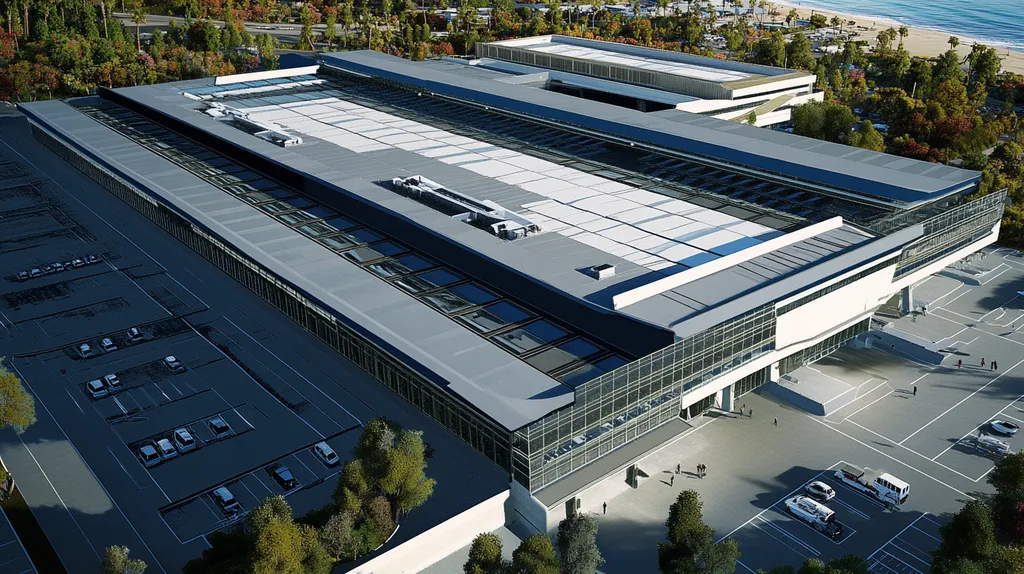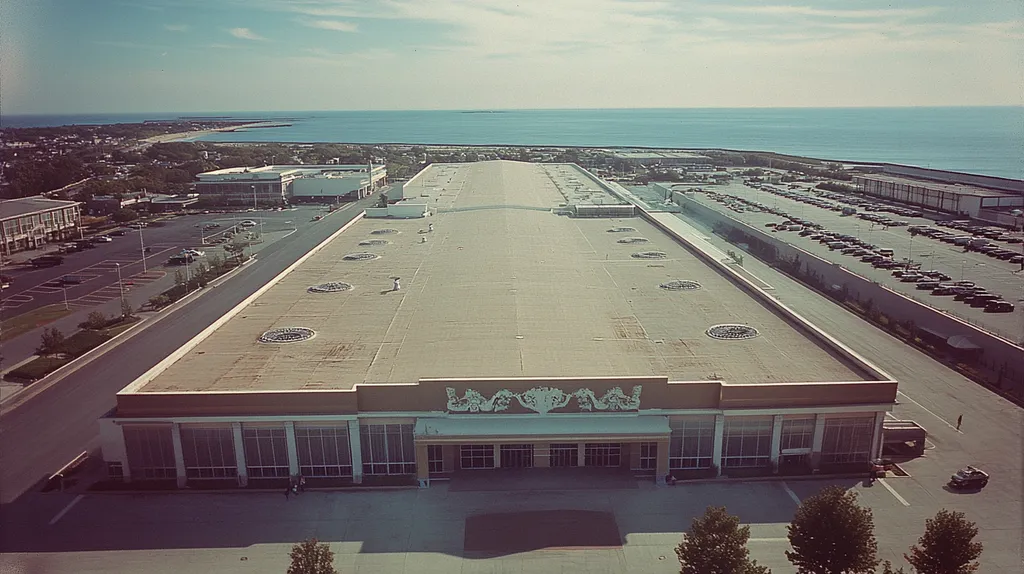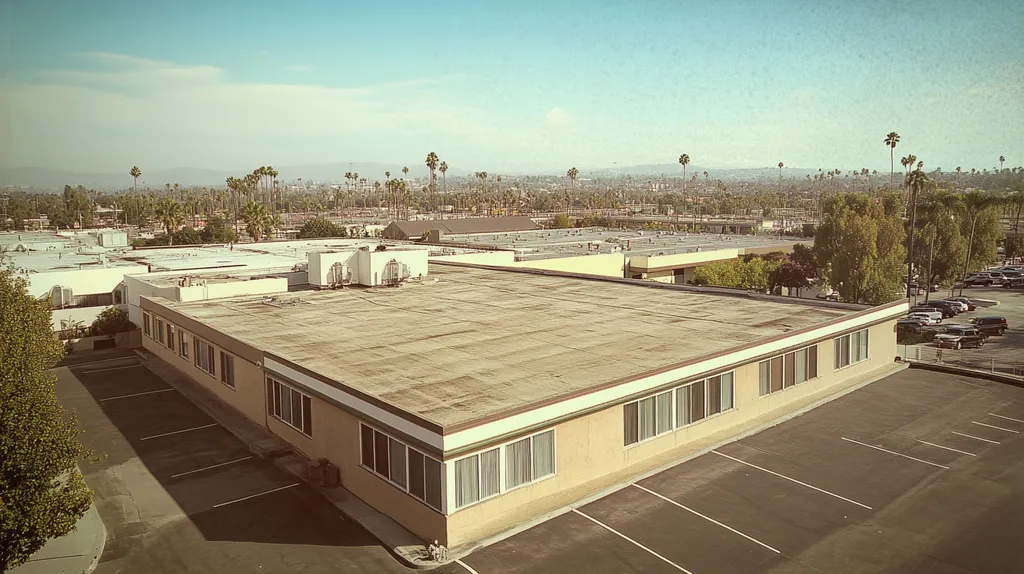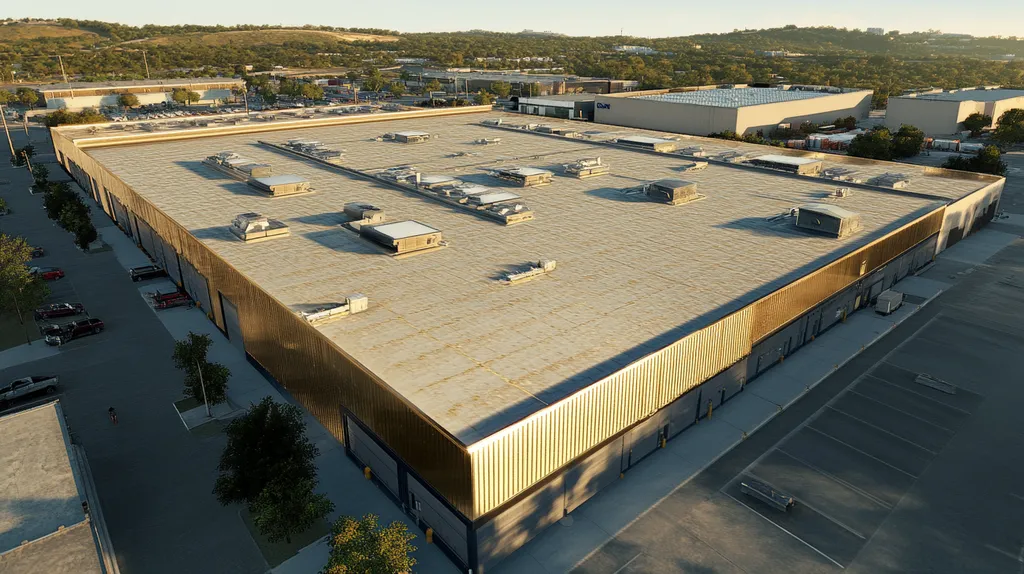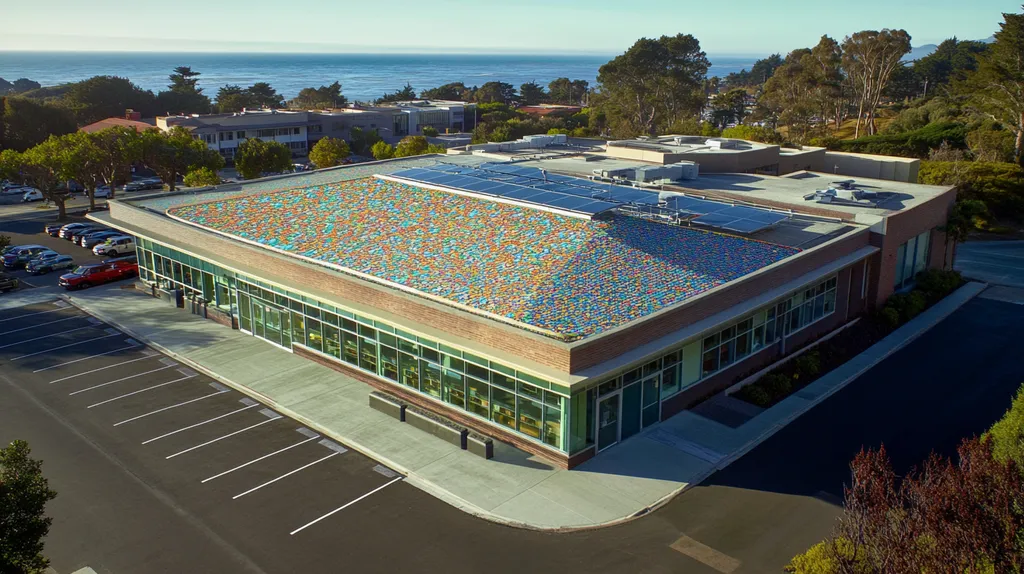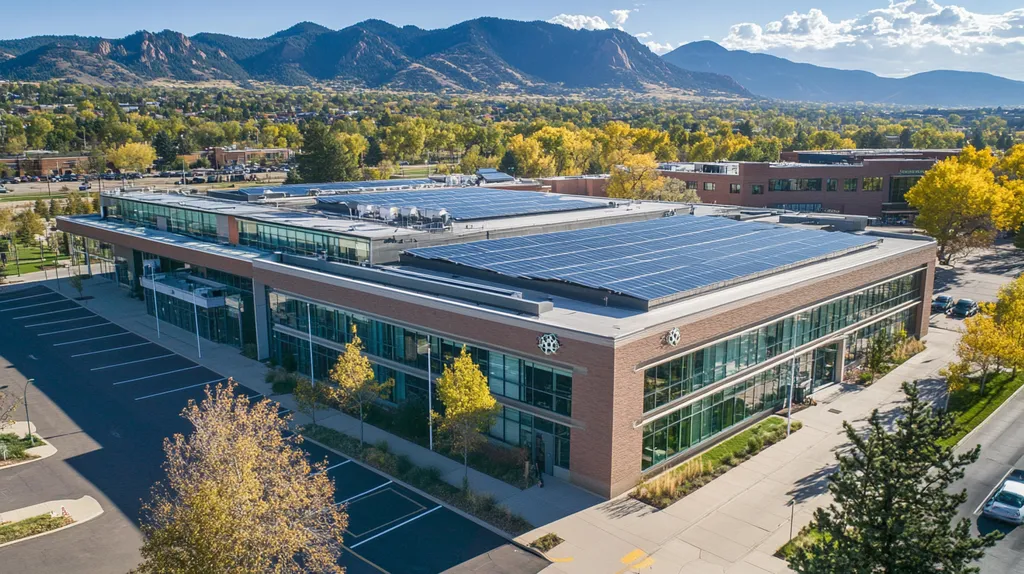When it comes to industrial roof repairs, sticker shock is a common ailment—one that claims countless unprepared facility budgets each year. With typical repairs ranging from $5,000 for minor fixes to upwards of $50,000 for major overhauls, understanding these costs isn’t just smart business—it’s essential survival.
The price tag for ignoring roof maintenance can be particularly steep: a simple leak can spiral into $20,000 worth of water damage overnight.
This comprehensive guide breaks down the real costs of industrial roof repairs, from common patch jobs to full system replacements, equipping property managers with the knowledge to budget effectively and avoid costly surprises.
SECTION 1: THE BASICS EXPLAINED
Understanding industrial roof repairs isn’t just a good idea—it’s essential for any commercial property owner or facility manager. Ignoring potential costs can lead to sky-high expenses in emergency repairs or structural damage. For example, a mere leak can spiral into a staggering $20,000 in water damage if left unattended. This section will demystify what industrial roof repairs really involve, highlight their significance for building integrity, and explain how the repair process unfolds.
What It Is (In Plain Language)
Industrial roof repairs encompass the maintenance and restoration efforts for commercial roofing systems. This might mean patching leaks, replacing worn-out materials, or even undergoing full roof replacements. The approach to repairs depends on the roof’s age, condition, and materials used.
Common culprits that call for repairs include membrane tears, punctures, and damaged flashing. Regular maintenance checks are like routine doctor visits—they help catch minor issues before they become major headaches.
Areas that often need attention include seams, drainage systems, and insulation. Grasping the function and health of these components is indispensable for effective long-term planning.
Being proactive about roof repairs not only ensures compliance with safety standards but also significantly extends the roof’s lifespan—a priority for facility managers aiming to safeguard their investments.
Why It Matters (To Your Building)
The integrity of an industrial roof is critical to maintaining a safe and operational facility. A compromised roof can lead to disruptions and financial pitfalls. For example, roof leaks can wreak havoc on machinery and inventory and even threaten the building’s entire structure.
A well-maintained roof can also enhance energy efficiency. If heat escapes or unwanted air infiltrates, it can drive up energy bills, significantly impacting overall operational costs.
Furthermore, neglecting repairs can hike up insurance premiums. Insurance companies often examine a roof’s condition when determining rates or coverage options. Keeping a roof in good shape can substantially reduce these costs.
Ultimately, understanding the consequences of deferring roof repairs equips property owners to manage their resources wisely and make informed choices.
How It Works
The repair process starts with a thorough roof inspection. Skilled professionals assess the condition of the roof to discover every area needing attention. This includes identifying visible damage, leaks, and wear-and-tear signs.
Once the inspection is complete, property owners receive a detailed report outlining necessary repairs and associated costs. This level of transparency helps in crafting better budgets and planning.
The actual repair work can vary widely, depending on the severity of the damage. Quick fixes like resealing or patching can be cost-effective and swift, whereas extensive issues might require specialized materials and more complex techniques.
After repairs are completed, ongoing maintenance is essential. Regular inspections keep an eye on emerging issues, ensuring the roof retains its integrity and longevity.
SECTION 2: PRACTICAL APPLICATIONS
Understanding the practical applications of industrial roof repairs is not just advisable—it’s absolutely vital for property owners and facility managers. With industrial roofs vulnerable to the ravages of Mother Nature and daily wear, timely maintenance is essential. A neglected roof can result in astronomical costs, soaring to $20,000 or more in damages. This section will uncover common repair scenarios, highlight crucial moments when action is needed, and illustrate how roof systems interact with other building components.
Common Uses & Examples
Industrial roof repairs typically address issues like leaks, punctures, and general wear and tear. For example, a simple roof leak can snowball into costly water damage, jeopardizing both equipment and inventory. Regular inspections act like an early warning system, allowing property owners to pinpoint problems before they escalate, potentially saving thousands in emergency repairs.
A common repair procedure involves restoring roofing membranes, especially for flat roofs. This can include resealing seams or replacing damaged panels. By staying ahead of maintenance, property owners can often extend the lifespan of their roofs by a decade or more—quite the return on investment!
Applying protective coatings is another key repair method. These coatings not only boost energy efficiency but also fend off UV rays and moisture. This small initial investment can yield significant savings on utility costs and prolong the life of the roof.
Timely repairs and proactive maintenance are crucial for ensuring the safety of both employees and clients. Leaks aren’t just inconvenient; they can create hazardous conditions that lead to potential injuries and liability claims.
When You Need It Most
Recognizing when to initiate roof repairs is vital for safeguarding safety and operational efficiency. Storm damage typically signals an immediate need for repairs. After severe weather events, property owners should conduct inspections for visible damage, such as bent edges or missing tiles, that could compromise the roof’s integrity.
Seasonal transitions—especially in fall and spring—are also critical times for roof assessments. Debris accumulation, such as leaves or snow, can clog drainage systems, leading to ponding water and leaks. Regular checks during these periods can mitigate risks before they escalate.
In addition to seasonal checks, routine maintenance should include monitoring wear and tear on materials. For single-ply membranes, this means regularly evaluating for punctures or shrinkage, while built-up roofs may require vigilance for blisters or cracks.
Delaying repairs until issues worsen can result in irrevocable damage. Regular assessments and prompt repairs can protect against costly, larger-scale fixes down the line.
Interactions With Other Systems
The condition of the roof has direct implications for other building systems, including HVAC and electrical components. Leaks can damage HVAC units, leading to expensive repairs and inefficiencies. Additionally, water exposure can corrode electrical systems, creating both safety hazards and disruptions in operations.
Furthermore, a roof’s insulation plays a pivotal role in maintaining energy efficiency. Postponed repairs can lead to heat loss, significantly inflating energy bills. Therefore, property managers must consider how insulation shortcomings link with comprehensive roof maintenance.
Roof repairs also interact with critical safety systems, such as fire alarms and sprinklers. Water damage has the potential to compromise these systems, risking compliance with safety regulations. Ensuring timely roof repairs is thus vital for maintaining robust safety protocols.
Interdisciplinary collaboration between roofing contractors and facility management teams can enhance the overall performance of the building. By synchronizing all systems, property managers create a safer and more efficient environment for everyone involved.
SECTION 3: KEY TERMINOLOGY DECODED
Navigating the world of industrial roofing requires a solid understanding of the terminology involved. Misunderstanding key terms can lead to frustrating budgeting woes and costly oversights. For example, not distinguishing between a “repair” and a “replacement” can create unrealistic financial expectations, possibly leading to unwelcome surprises down the line. This section aims to clarify essential roofing terminology, empowering property owners and facility managers to tackle their roofing challenges with confidence.
Essential Terms Explained
Grasping terms like “roofing membrane” and “flashing” is foundational for understanding roofing systems. A roofing membrane acts as your roof’s protective barrier, keeping water out and shielding the structure beneath. In contrast, flashing is a critical element used to divert water away from seams and joints, ensuring longevity and reducing the risk of leaks. Failing to recognize these differences can set the stage for inadequate repairs and rising long-term costs.
Then there’s “decking”—the unsung hero of roofing. This structural component provides essential support for the roofing system, bearing its weight and ensuring durability. Appreciating the difference between decking and other roof components is vital for accurately assessing repair needs and associated costs.
Let’s not overlook “thermal insulation.” This key player helps control energy efficiency and building temperature. When property managers are fluent in these terms, they’re better positioned to make decisions that optimize their budgets and protect their investments.
Industry Jargon Translated
The roofing industry is rife with jargon that can leave the uninitiated scratching their heads. Take “TPO” (Thermoplastic Polyolefin) and “EPDM” (Ethylene Propylene Diene Monomer), for instance. TPO is prized for its energy conservation properties, while EPDM stands out for its durability in turbulent weather. Understanding these materials can significantly influence roofing choices and budgeting.
Keeping an eye on terms like “ponding” is equally important. If water stagnates on the roof post-rainfall, it can turn into a breeding ground for leaks and structural damage. Recognizing this term is essential for ensuring adequate maintenance and preventing expensive repairs.
Finally, the “R-value” quantifies insulation effectiveness. A higher R-value translates to superior insulation, which can lead to noticeable energy savings. It’s crucial for property managers to factor insulation into their budgets, as it can impact both immediate repair costs and long-term energy expenditures.
Measurement & Units Simplified
Roofing measurements are commonly expressed in square feet, and grasping this unit is key for accurate estimates. For example, a 5,000-square-foot roof will have vastly different material and labor needs compared to its smaller counterparts. Miscalculating these dimensions can easily spiral into budget overruns.
Furthermore, the roof slope is an important specification often described as a ratio—like 4:12, indicating a rise of 4 inches for every 12 inches of horizontal run. Understanding the implications of slope helps ensure that the correct materials and labor are utilized, which is crucial for keeping costs in check.
Lastly, familiarity with roofing “warranties” is essential. These warranties vary significantly, ranging from a few years to several decades, depending on the materials used. Evaluating these warranties allows property owners to anticipate future costs and identify potential savings, thereby enhancing effective financial planning.
SECTION 4: DECISION FACTORS
When it comes to industrial roof repairs, understanding the decision factors is not just beneficial—it’s essential for effective budgeting and strategic planning. Overlooking these elements can lead to unexpected costs and even greater risks for the building. A compromised roof can trigger inventory loss, inflate energy bills, and introduce safety hazards. This section examines key considerations such as cost, performance trade-offs, and lifespan factors to assist property owners and facility managers in navigating their decision-making process.
Cost Considerations
Cost plays a leading role in every roofing decision. Initial repair expenses can vary widely based on materials, labor, and the extent of damage. A simple patch may only set you back a few hundred dollars, while a full re-roofing project can climb to tens of thousands.
When budgeting, it’s important to factor in both immediate and potential future costs. Ongoing maintenance and routine inspections can stave off bigger problems later on, translating into financial savings down the road. While quality materials might seem like a high upfront investment, they could save money in repairs over time.
Local labor market rates are another key consideration. In regions with labor shortages, costs can escalate quickly. Staying informed about local conditions will help prevent the shock of inflated estimates.
Ultimately, an in-depth understanding of these costs empowers property owners to prioritize resources effectively and allocate funds where they’re truly needed.
Performance Trade-offs
When deciding on roofing solutions, performance trade-offs come into play. Various roofing materials have differing levels of durability, insulation, and resistance to the elements. For example, while an economical TPO roof may cost less initially, it could lead to more frequent repairs compared to a sturdy metal roof.
Evaluating which option best fits the building’s specific needs is crucial. Regulatory requirements, climate factors, and the building structure itself all influence which performance traits are most relevant. In harsher climates, opting for robust materials can help mitigate wear and tear.
Weighing short-term cost savings against long-term investment is a balancing act. A temporary fix might lighten the current budget but could ultimately result in larger expenses in the future.
Recognizing these trade-offs enables decision-makers to make choices that both optimize cost and enhance performance.
Lifespan & Durability Factors
Lifespan and durability are critical elements in roof repair planning. Various roofing materials have different expected lifespans. For instance, an EPDM roof can last around 20 years, whereas a well-installed metal roof might exceed 40 years.
Investing in durable materials pays off significantly in the long run. A reliable roof reduces repair frequency and minimizes the risk of damage to the underlying structure, making the overall lifecycle cost a key consideration for property owners.
Durability is also affected by installation quality and local environmental conditions. Ensuring that experienced professionals handle the installation can lead to enhanced longevity. Therefore, property owners should prioritize hiring certified contractors to avoid premature failures.
By contrasting lifespan and durability with initial costs and performance, stakeholders can make informed decisions that bolster the integrity of their industrial roofs.
SECTION 5: COMMON CHALLENGES
Industrial roof repairs often present unexpected challenges that can jeopardize facility operations. Missing a maintenance window or overlooking a minor issue can result in significant structural damage, leading to pricey repairs and unwanted downtime. Alarmingly, research indicates that 50% of commercial properties encounter unanticipated roof leaks, leading to potential inventory loss and safety risks. Understanding these challenges is critical for effective budgeting and proactive planning.
Frequent Problems & Solutions
Many industrial roofs are plagued by common issues such as leaks, ponding water, and membrane degradation. Leaks frequently occur around seams or penetrations, warranting immediate attention to stave off more extensive damages. For example, a compromised roof membrane may allow water to infiltrate, leading to serious structural concerns.
Conducting routine inspections can help identify problems sooner, enabling targeted repairs instead of costly replacements. Facility managers should emphasize regular assessments, especially in areas prone to heavy rainfall or snow. Partnering with qualified roofing contractors ensures that repairs comply with industry standards, minimizing future headaches.
Ponding water on flat roofs is another persistent issue that can pose serious risks, including potential roof collapse if neglected. Installing adequate drainage systems can dramatically reduce this risk. Moreover, opting for robust materials designed for local weather conditions can enhance longevity and resilience.
Establishing a consistent maintenance schedule is essential for tackling these frequent challenges. By catching problems early, property owners can prevent minor issues from escalating into major financial burdens.
Warning Signs To Watch For
Identifying roofing problems early is paramount to avoiding costly repairs. Common warning signs include visible leaks, sagging roof areas, and even mold or mildew growth. Property managers are encouraged to conduct thorough visual inspections regularly to catch these symptoms early.
Interior water stains on ceilings or walls typically signal roof issues that need immediate intervention. Additionally, rust on metal flashing or gutters may indicate moisture damage that requires prompt attention. Staying vigilant about these details can significantly extend the life of the roof.
Cracks or blisters in the roof membrane should not be ignored, as they can lead to leaks and other structural problems. Seasonal inspections can help detect these early warning signs, allowing for timely repairs before they spiral into larger issues.
Utilizing technology like infrared scans can also be advantageous. These tools can identify hidden moisture damage that might escape notice during standard inspections, giving property managers a fuller picture of the roof’s health.
Preventative Approaches
Implementing preventative maintenance is crucial for extending the life of industrial roofs. Regular inspections, suggested to occur at least twice a year, can help catch potential problems before they escalate into costly repairs. This proactive approach is a strategic investment for any facility manager.
Simple measures, such as keeping gutters free of debris, are effective strategies for prevention. Clogged gutters can lead to overflowing and consequent water damage, but this can be easily avoided with regular upkeep.
Moreover, investing in high-quality roofing materials can significantly lower the frequency of repairs. Advanced materials tailored to specific climates can offer enhanced protection against common weather-related issues.
Building a relationship with a reputable roofing contractor is invaluable. These experts can provide insights on customized maintenance plans, ensuring roofs remain in optimal condition while minimizing long-term costs.
SECTION 6: NEXT STEPS & RESOURCES
Understanding the costs associated with industrial roof repairs is just the tip of the iceberg. Property owners and facility managers must take proactive steps to safeguard their investments and ensure operational safety. In an industry marked by rapid changes, engaging the right experts is crucial; failure to do so can lead to overspending or inadequate repairs. By asking the right questions, familiarizing themselves with industry standards, and pursuing ongoing education, stakeholders can stay ahead in the roofing game.
Questions To Ask Providers
Before hiring a roofing contractor, establishing clear communication is essential. Asking pointed questions can illuminate a provider’s qualifications and their approach to quality. For example, inquire about their experience with your specific roofing type and request references or case studies that showcase their capabilities.
It’s also vital to ask about the materials they recommend and the rationale behind their choices. Understanding the long-term cost benefits of premium materials versus budget options can save a fortune down the road. Additionally, clarify the warranties and guarantees linked to their work; this could be a financial lifesaver in the future.
Lastly, ask for a detailed estimate that breaks down labor, materials, and any additional costs. This transparency will aid in budgeting and facilitate comparisons among different providers. Knowing what to ask can lead to informed decisions that protect the roof and ensure peace of mind.
Industry Standards & Guidelines
Being acquainted with industry standards is crucial for smart roofing decisions. Organizations like the National Roofing Contractors Association (NRCA) provide guidelines on best practices for roofing repairs, ensuring that work meets or surpasses safety and durability benchmarks.
Resources like ASTM International standards can also keep property owners informed about the necessary materials and testing methodologies for repair projects. Adhering to these standards minimizes risk and contributes to improved long-term performance.
Don’t overlook local building codes, either. Every region has its own regulations dictating what can be done in roofing repairs. Ensuring compliance is essential for protecting investments and avoiding legal complications that could derail projects. Knowledge is power; understanding these standards empowers more secure decisions.
Further Learning Simplified
In the fast-paced world of industrial roofing, ongoing education is indispensable. Property owners and facility managers should actively seek out webinars, workshops, and training programs focused on roofing technologies and repair techniques. These resources provide valuable insights into the latest innovations that can enhance the longevity of roofing systems.
Subscribing to industry publications or joining trade associations can also offer access to crucial information and updates. Networking with other professionals allows for the sharing of experiences and best practices, turning knowledge into actionable strategies for success.
Finally, consider exploring online platforms that offer courses specifically designed for property management and maintenance professionals. These courses break down complex concepts, enabling individuals to make well-informed decisions regarding their roofing needs. A little learning goes a long way in preventing costly mistakes!
The Bottom Line
With industrial roof repairs ranging from $5,000 to $50,000, the financial stakes couldn’t be higher for facility managers and property owners.
Understanding these costs isn’t just about budgeting—it’s about protecting millions in assets, equipment, and inventory that rely on a properly maintained roof.
The math is clear: preventative maintenance and timely repairs cost significantly less than emergency fixes or full replacements.
By leveraging professional assessments, implementing regular maintenance schedules, and staying current with industry standards, facility managers can extend their roof’s lifespan while minimizing repair costs.
In the high-stakes world of industrial roofing, knowledge truly is power—and that power translates directly to the bottom line.
FREQUENTLY ASKED QUESTIONS
Q. What are the basics of industrial roof repairs?
A. Industrial roof repairs involve maintaining and restoring commercial roofing systems, like patching leaks and replacing materials. This is crucial since ignoring minor issues can escalate repair costs and damage. Regular maintenance checks can identify problems early, safeguarding the structural integrity of your building.
Q. When should I consider industrial roof repairs for my property?
A. Industrial roof repairs are essential after severe weather events or during seasonal changes. Roof inspections during these times help catch issues like leaks or debris accumulation before they escalate. Timely repairs can prevent extensive damage and reduce future repair costs.
Q. What are some key terms related to commercial roofing?
A. Understanding terms like “roofing membrane,” “flashing,” and “thermal insulation” is vital for property owners. Each plays a role in roof protection and efficiency. Misunderstanding these terms can lead to budgeting mishaps; therefore, familiarizing yourself with roofing jargon is crucial for informed decision-making.
Q. How do cost considerations affect industrial roof repairs?
A. Cost considerations play a significant role in roofing decisions. Initial repair costs can vary widely based on materials, labor, and damage extent. Understanding both immediate and future costs is crucial; investing in quality materials often saves money long-term by reducing repair frequency.
Q. What common challenges arise during roof repairs?
A. Common challenges include unnoticed leaks, ponding water, and membrane degradation. These issues can escalate repair costs and cause operational disruptions. Establishing a consistent maintenance schedule and monitoring warning signs can help address these challenges before they turn into costly repairs.
Q. What next steps should I take after learning about industrial roof costs?
A. After understanding repair costs, engage with roofing contractors by asking clear questions about their qualifications and approaches. Familiarize yourself with industry standards and guidelines, and seek ongoing education to stay updated on best practices that can protect your investment.
Q. How can I improve my building’s energy efficiency through industrial roof repairs?
A. Improving energy efficiency involves assessing insulation and applying protective coatings during repairs. By ensuring proper insulation and using energy-efficient materials, you can reduce heating and cooling costs significantly. Regular inspections also help maintain these efficiencies, enhancing your building’s overall performance.

